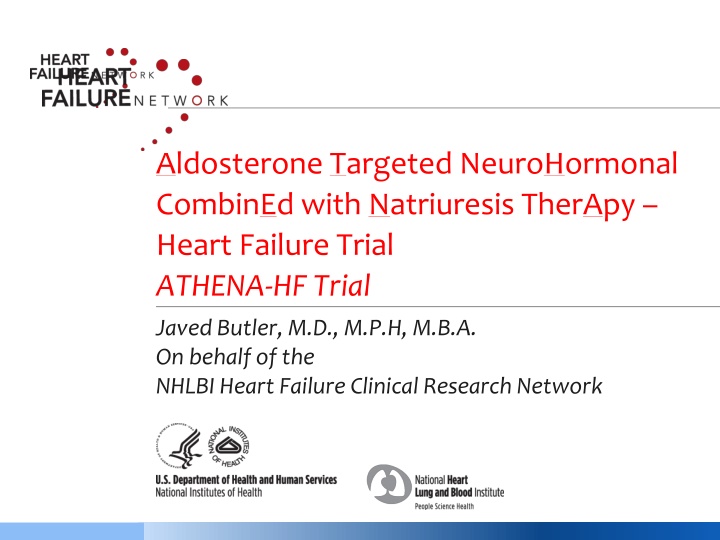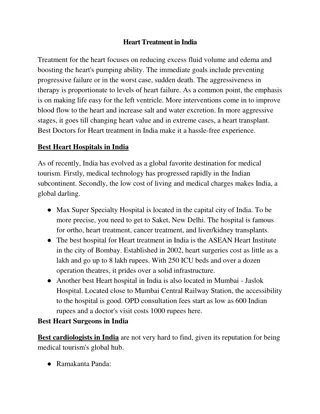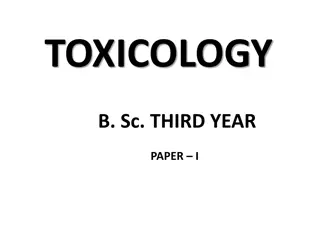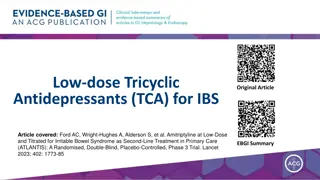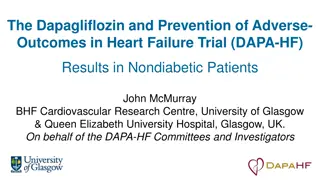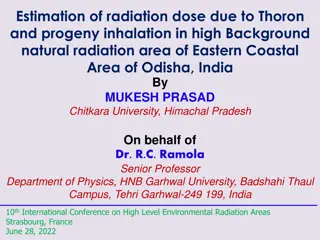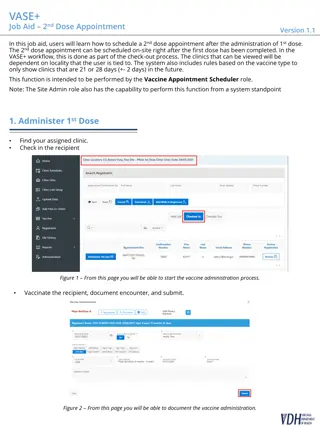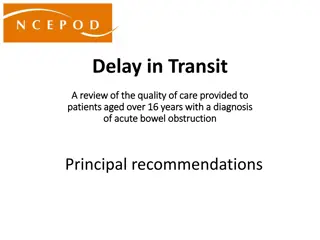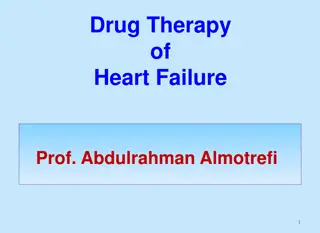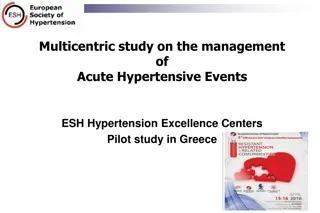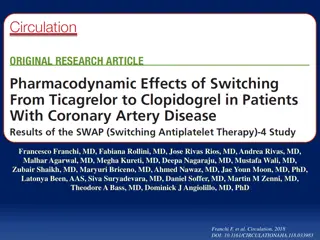Study on High-Dose Spironolactone in Acute Heart Failure Patients
The ATHENA-HF trial investigates the impact of high-dose spironolactone on reducing NT-proBNP levels in acute heart failure patients. Key objectives include assessing congestion, dyspnea relief, urine output, weight change, diuretic requirement, and outcomes like mortality and readmissions up to 60 days post-hospitalization. Inclusion criteria involve specific age, congestion symptoms, renal function, and biomarker levels. By targeting aldosterone pathways, the study aims to improve outcomes and management in acute heart failure.
Download Presentation

Please find below an Image/Link to download the presentation.
The content on the website is provided AS IS for your information and personal use only. It may not be sold, licensed, or shared on other websites without obtaining consent from the author.If you encounter any issues during the download, it is possible that the publisher has removed the file from their server.
You are allowed to download the files provided on this website for personal or commercial use, subject to the condition that they are used lawfully. All files are the property of their respective owners.
The content on the website is provided AS IS for your information and personal use only. It may not be sold, licensed, or shared on other websites without obtaining consent from the author.
E N D
Presentation Transcript
Aldosterone Targeted NeuroHormonal CombinEd with Natriuresis TherApy Heart Failure Trial ATHENA-HF Trial Javed Butler, M.D., M.P.H, M.B.A. On behalf of the NHLBI Heart Failure Clinical Research Network
Persistent Congestion and Outcomes in Acute Heart Failure Persistent clinical and sub-clinical congestion at discharge after AHF hospitalization is associated with worse outcomes. Pulmonary Capillary Wedge Pressure Natriuretic Peptide Levels Signs and symptoms Lucas C, et al. Am Heart J. 2000;140:840-847. Fonarow GC, et al. Circulation. 1994;90(pt. 2):1-488. Logeart D, et al. J Am Coll Cardiol. 2004;43:635-641
Acute Heart Failure Aldosterone levels and high-dose MRA Patients with AHF have elevated aldosterone levels that are associated with diuretic resistance and worse post-discharge outcomes Eur J Heart Fail. 2013;15(11):1228-35 High-dose mineralocorticoid receptor antagonists (MRA) therapy has been shown to overcome diuretic resistance in HF. Circ Heart Fail 2009; 2: pp. 370-376 In a single blind randomized trial of 100 patients, 50- 100mg spironolactone use in AHF was associated with improved congestion and renal function. Eur J Intern Med. 2014 Jan;25(1):67-72
Study Aim and Design To test the hypothesis that high-dose spironolactone use in patients with AHF will lead to greater reductions in NT-proBNP levels from randomization to 96 hr. Randomized, double blind, placebo-controlled, multicenter trial. Patients not on MRA at baseline were randomized to spironolactone 100 mg or placebo Those on low-dose spironolactone (12.5 or 25 mg) were randomized to 100 mg spironolactone or 25 mg spironolactone for 96h
Other Objectives 96 hours 1. Congestion score (dyspnea, orthopnea, fatigue, JVP, rales, edema) 2. Dyspnea relief 3. Net urine output 4. Net weight change 5. Loop diuretic dose requirement 6. In-hospital worsening of HF Day 30 1. All-cause mortality 2. All-cause readmissions 3. Outpatient worsening HF (HF readmissions or ED visits or observational unit stays for HF or need for outpatients IV diuretics) 4. MRA use 5. Loop diuretic dose 6. Index hospitalization length of stay Day 60 1. Vital status Safety 1. Change in serum creatinine 2. Hyperkalemia (>5.5mmol/L and >6.0mmol/L)
Key Inclusion Criteria Age 21 yrs At least 1 symptom and 1 sign of congestion eGFR of 30 mL/min/1.73m2 Serum K+ 5.0 mmol/l NT-proBNP 1000 pg/mL or BNP 250 pg/mL within 24h of randomization Not on MRA or on low-dose spironolactone (12.5 mg or 25 mg daily) at baseline Randomized within 24 hours of first IV diuretic dose
Key Exclusion Criteria Eplerenone or >25 mg spironolactone at home Systolic blood pressure <90 mmHg Significant arrhythmias or ICD shock within 1 wk ACS currently suspected or within the past 4 wk Current or planned LVAD within 30 days Post transplant or expected to receive one within 30d Current inotrope use
Study Flow and Enrollment 12/2014 to 4/2016 360 patients enrolled from 22 sites. 182 patients randomized to high-dose spironolactone 178 to usual care 132 placebo 46 continued low dose spironolactone
Clinical Characteristics Placebo Spironolactone Age (yr.) 65 (54, 74) 65 (57, 76) Female (%) 36 36 White/Black (%) 56/43 55/41 Myocardial Infarction (%) 30 28 Hypertension (%) 81 87 Atrial fibrillation (%) 48 50 Diabetes Mellitus (%) 42 40 Chronic Kidney Disease (%) 31 24 LVEF (%) 30 (20, 45) 35 (21, 50) Proportion <45% (%) 79 69
Baseline Treatment Placebo (%) Spironolactone (%) ACEI or ARB 63 58 Beta blockers 74 74 MRA 28 27 Loop diuretics 95 97 Hydralazine 26 24 Nitrates 19 19 Implanted defibrillator 42 35 Biventricular pacemaker 37 42
Vitals and Laboratory Data Baseline Characteristics Placebo Spironolactone SBP - mmHg 123 (108, 138) 120 (106, 138) Heart rate - bpm 80 (70, 94) 78 (70, 90) Body mass index 32 (27, 38) 30 (25, 35) Sodium - mEq/L 140 (138, 142) 140 (138, 142) Potassium - mEq/L 4 (3.6, 4.3) 3.9 (3.6, 4.3) Blood urea nitrogen - mg/dL 22 (17, 31) 23 (16, 33) Creatinine - mg/dL 1.3 (1.0, 1.5) 1.2 (1.0, 1.5) eGFR - ml/min/1.73 m2 55 (46, 71) 58 (45, 75)
Results - Primary Endpoint Placebo Spironolactone P Log NTproBNP 8.23 (7.58, 8.94) 8.43 (7.90, 9.17) Baseline 96 h (or discharge) 7.64 (6.93, 8.45) 7.89 (7.19, 8.68) Change -0.49 (-0.98, -0.14) -0.55 (-0.92, -0.18) 0.57 N-terminal pro B-type natriuretic peptide, pg/ml Baseline 3753 (1968, 7633) 4601 (2697, 9596) 96 h (or discharge) 2080 (1025, 4675) 2672 (1326, 5896) Change -1072 (-3182, -231) -1796 (-3883, -571) 0.76
Dyspnea and Congestion Placebo Spironolactone P Dyspnea - Likert Score 2 (1, 3) 2 (1, 3) 0.30 Dyspnea Visual Analog Scale Baseline 65 (40, 75) 60 (45, 75) 96 h 83 (70, 90) 80 (65, 90) 96 h Change 15 (5, 30) 15 (2, 30) 0.61 Placebo Spironolactone P Clinical congestion score Baseline 11 (9, 12) 10 (9, 12) 96 h 4 (2, 6) 4 (2, 7) Change -6 (-8, -4) -6 (-8, -4) 0.416
Urine Output and Weight Change Placebo Spironolactone P Net urine output, mL 24 h 1183 (510, 1955) 1100 (483, 2131) 0.76 48 h 2282 (1155, 4135) 2484 (1203, 4411) 0.44 72 h 3810 (2011, 5565) 4171 (2053, 6040) 0.53 96 h 5584 (2924, 8132) 6086 (2780, 8420) 0.57 Weight change, Ibs Baseline 207.1 (171.0, 250.4) 195.0 (162.6, 237.0) 96 h or early discharge 198.9 (167.6, 243.6) 185.1 (158.5, 230.8) Change -6.1 (-11.2, -1.8) -7.3 (-13.0, -2.0) 0.33
Diuretic Use and Worsening Heart Failure Placebo Spironolactone P Furosemide equivalent diuretic dose, mg Baseline 160 (120, 320) 160 (100, 320) 96 h 80 (40, 240) 80.0 (40, 200) 96 h change -80 (-160, 0.0) -80.0 (-160, 0) 0.77 Placebo Spironolactone P Worsening heart failure (%) Inpatient 18 19 0.76 Outpatient 10 11 0.76
Hyperkalemia Placebo Spironolactone P Change in serum potassium mEq/L. Median (25th, 75th 24 h 0.00 (-0.40, 0.30) 0.00 (-0.30, 0.30) 0.50 48 h 0.10 (-0.3, 0.40) 0.10 (-0.10, 0.40) 0.02 72 h 0.20 (-0.40, 0.55) 0.20 (-0.20, 0.60) 0.08 96 h 0.20 (-0.30, 0.60) 0.30 (0.00, 0.70) 0.08 One patient in the placebo group developed serum K levels between 5.5-5.9 mmol/L No one developed K concentration > 6.0 mmol/L
Renal Function Placebo Spironolactone P Change in serum creatinine - mg/dL. Median (25th, 75th) 24 h 0.05 (-0.05, 0.20) 0.05 (-0.03, 0.17) 0.76 48 h 0.02 (-1.10, 0.20) 0.10 (-0.03, 0.20) 0.67 72 h 0.08 (-0.08, 0.22) 0.10 (-0.03, 0.28) 0.85 96 h 0.10 (-0.02, 0.33) 0.10 (-0.05, 0.27) 0.77 Change in eGFR- ml/min/1.73 m2. Median (25th, 75th) 24 h -1.95 (-8.46, 2.79) -2.58 (-7.83, 1.53) 0.87 48 h -1.59 (-9.65, 3.71) -4.12 (-8.87, 1.89) 0.95 72 h -3.70 (-12.06, 4.09) -3.71 (-10.67, 0.87) 0.82 96 h -5.53 (-13.11, 0.79) -4.35 (-11.06, 1.74) 0.56
Post Discharge Outcomes Median time to discharge: 4 (2, 7) days in both groups. Two patients in each arm died in-hospital 7 patients in placebo and 5 in spironolactone arm died by day 30. No significant difference in post-discharge mortality, HF hospitalization, or ED visit. 47% in placebo and 43% in spironolactone arm had SAE by day 30
Sub-group analysis No differences in the primary endpoint between patients stratified by Age (< or > 65 years) Gender Baseline use of low dose vs. no spironolactone Change in log NTproBNP in the spironolactone and placebo groups respectively was EF< 45% was -0.55 (-0.92, -0.19) and -0.54 (-0.99, -0.15), EF >45% was -0.53 (-1.03, -0.14) and -0.42 (-0.64, -0.03) (interaction P=0.078)
Conclusion In ATHENA-HF, 100mg/day spironolactone for 96 hr in AHF did not achieve its primary aim of reducing NTproBNP level more than usual care alone None of the secondary endpoints differed between the 2 groups Dyspnea relief, clinical congestion, net urine output, weight lose, or clinical events High dose spironolactone was well tolerated No significant difference in worsening renal function or hyperkalemia between the two groups These data do not support the routine use of high dose spironolactone in AHF. The role of high dose MRA targeted to patients resistant to loop diuretics needs to be further studied.
